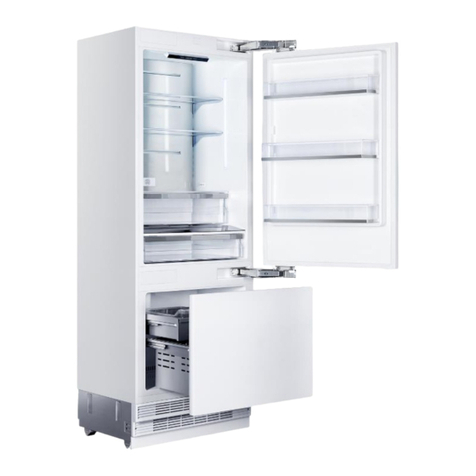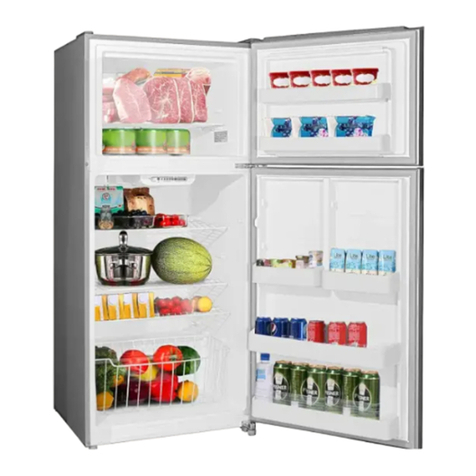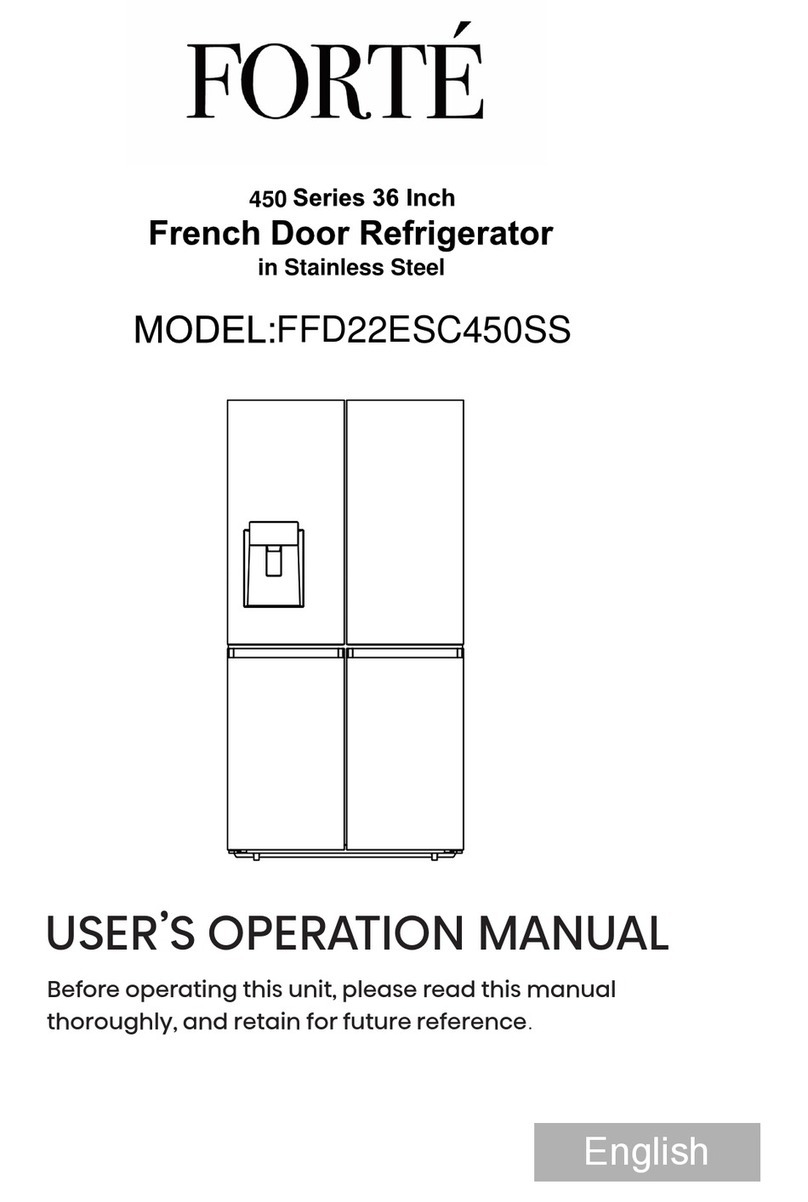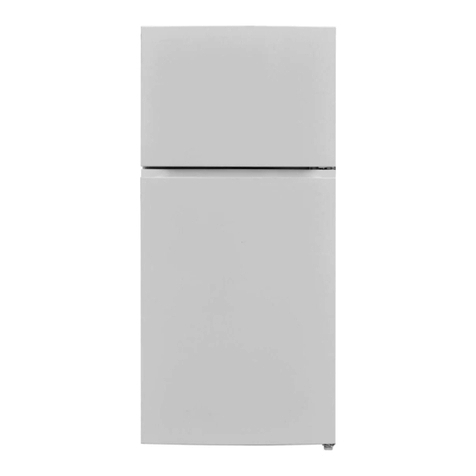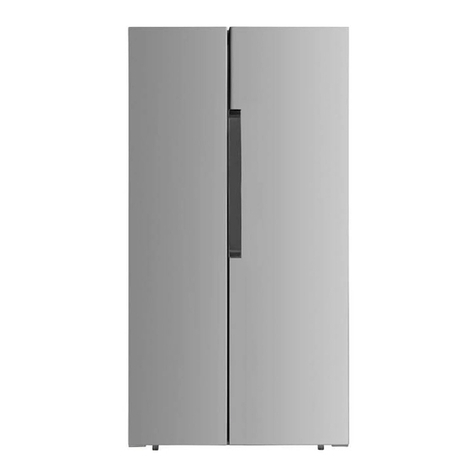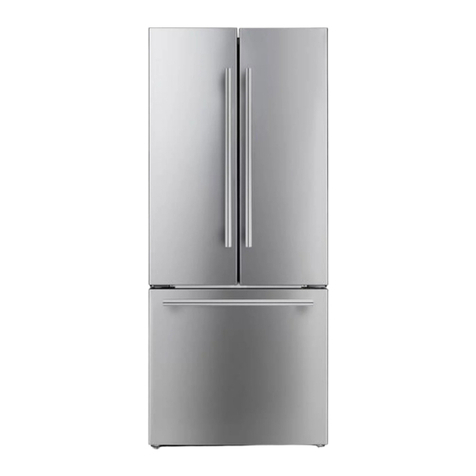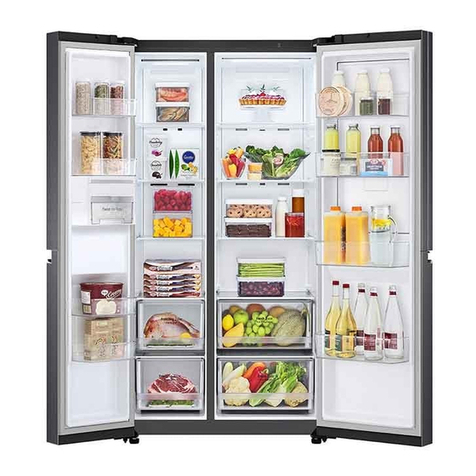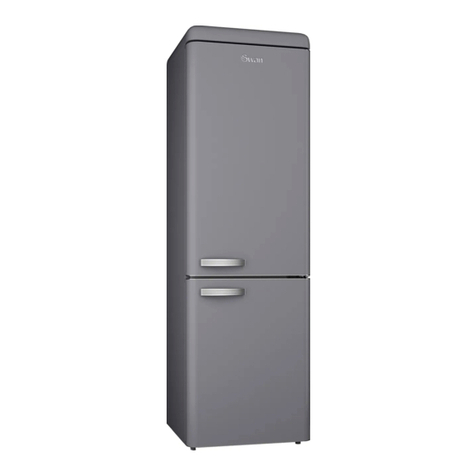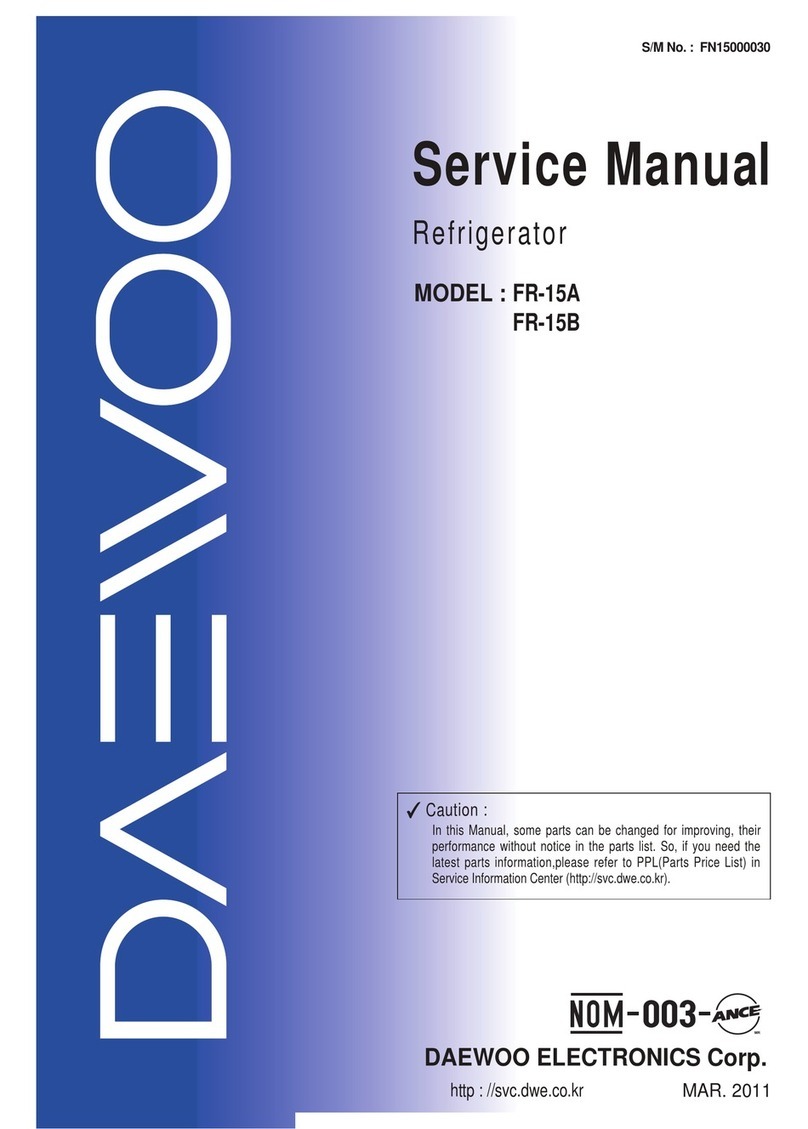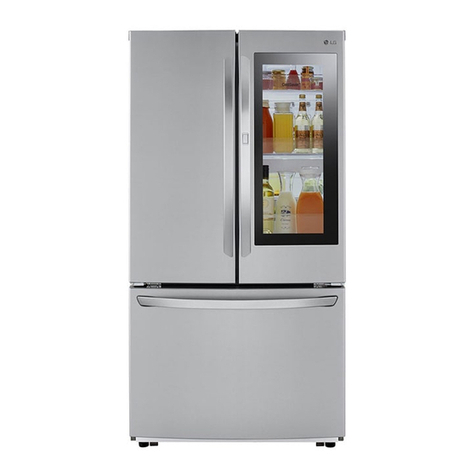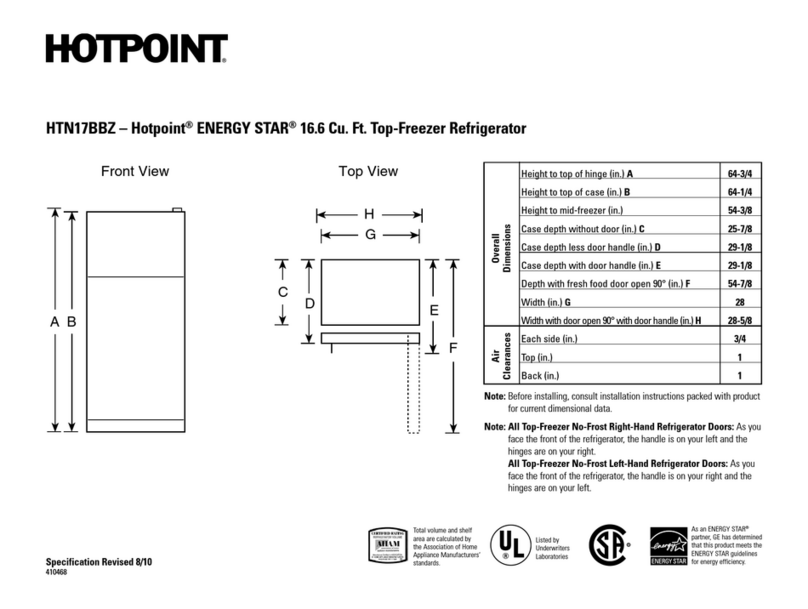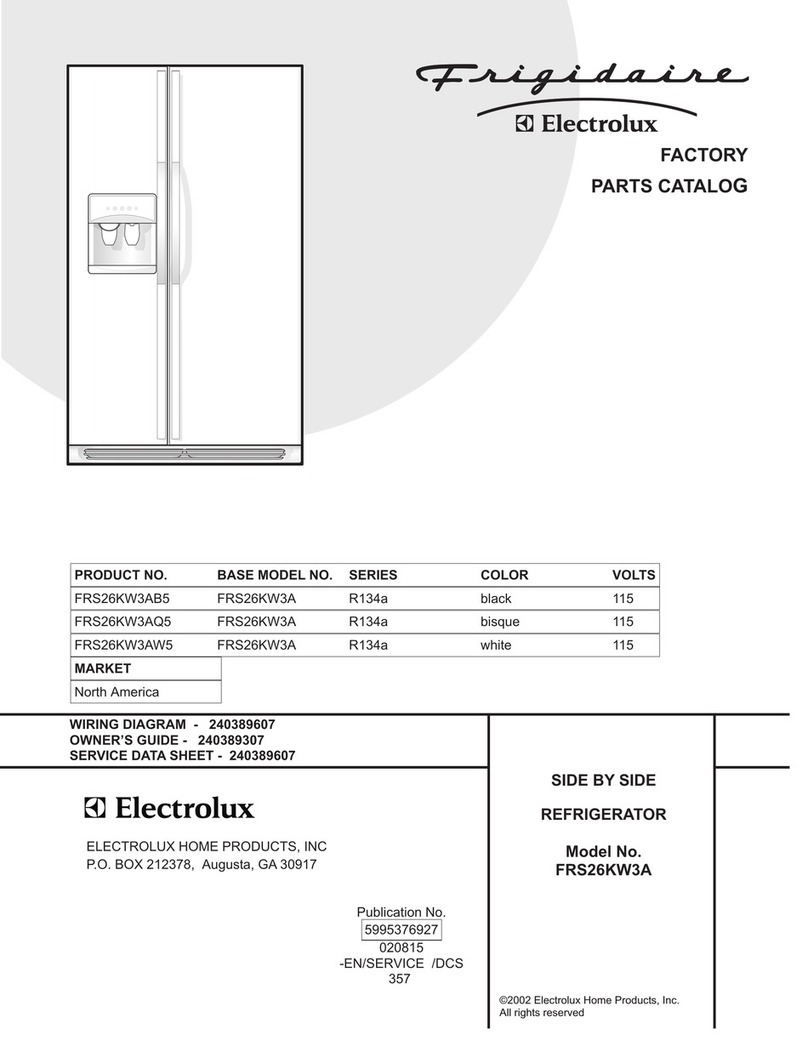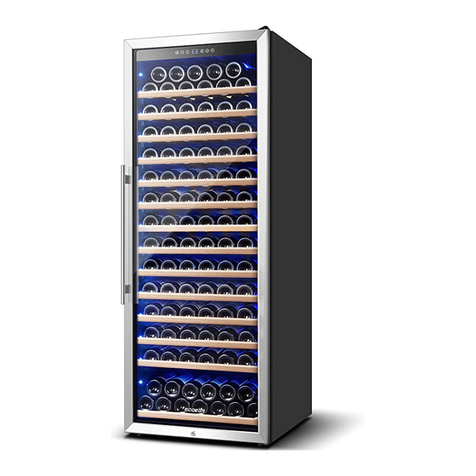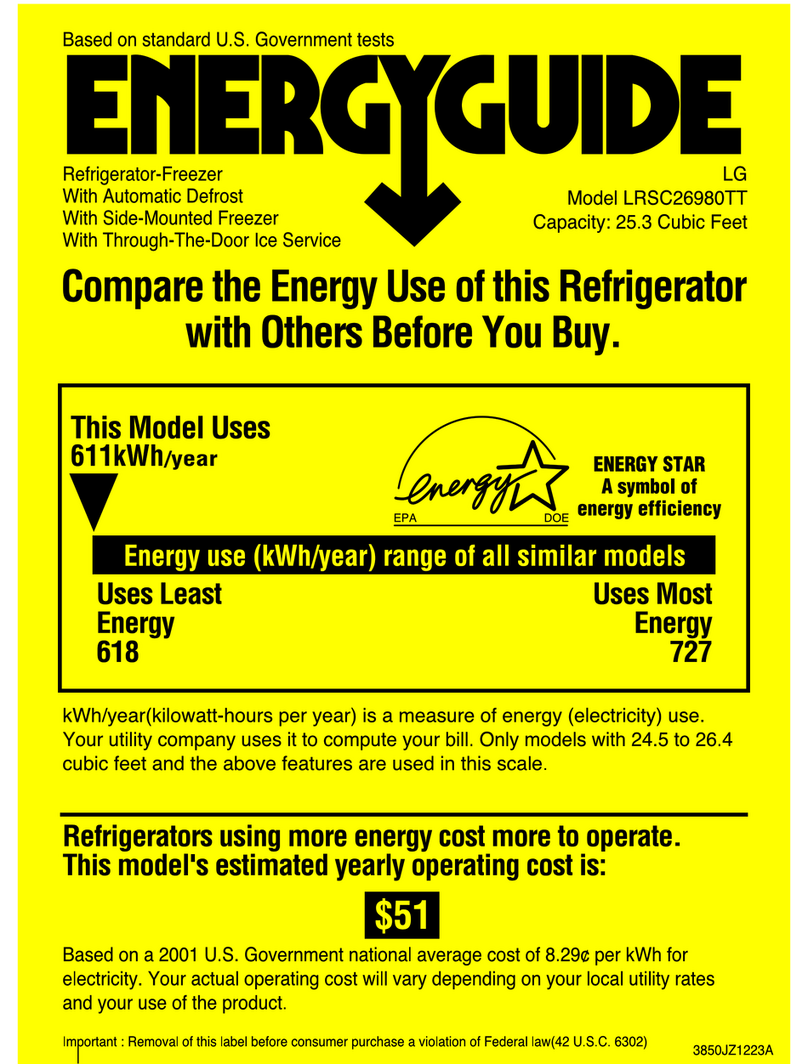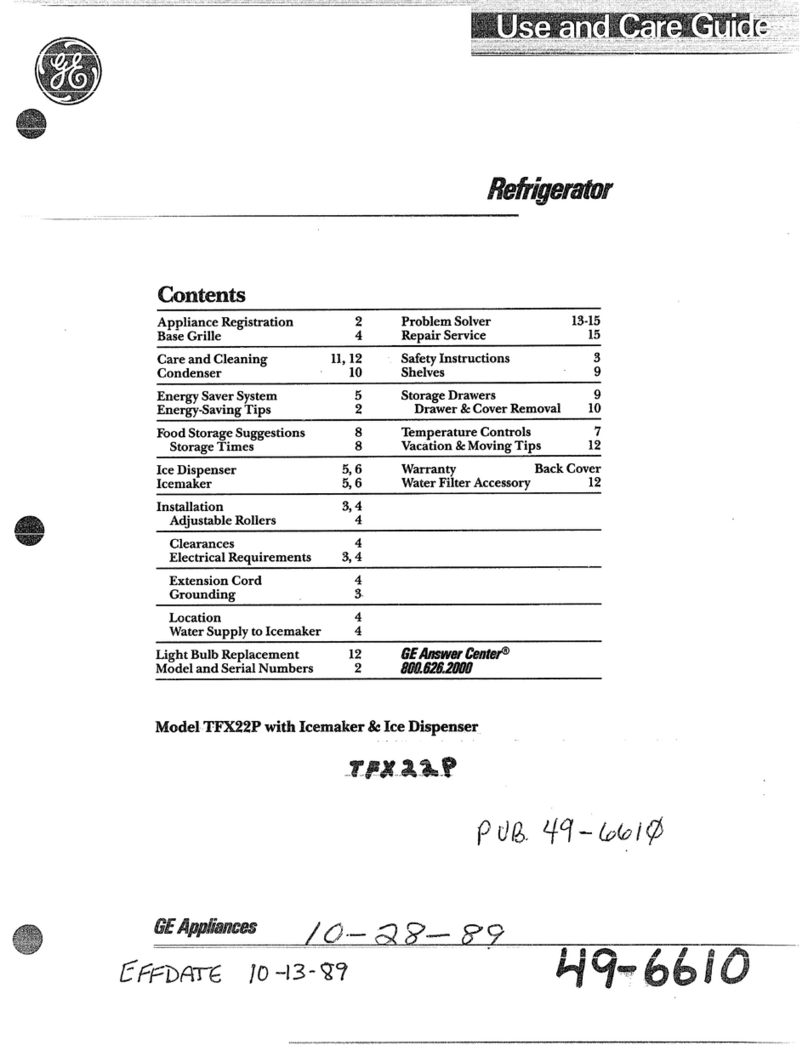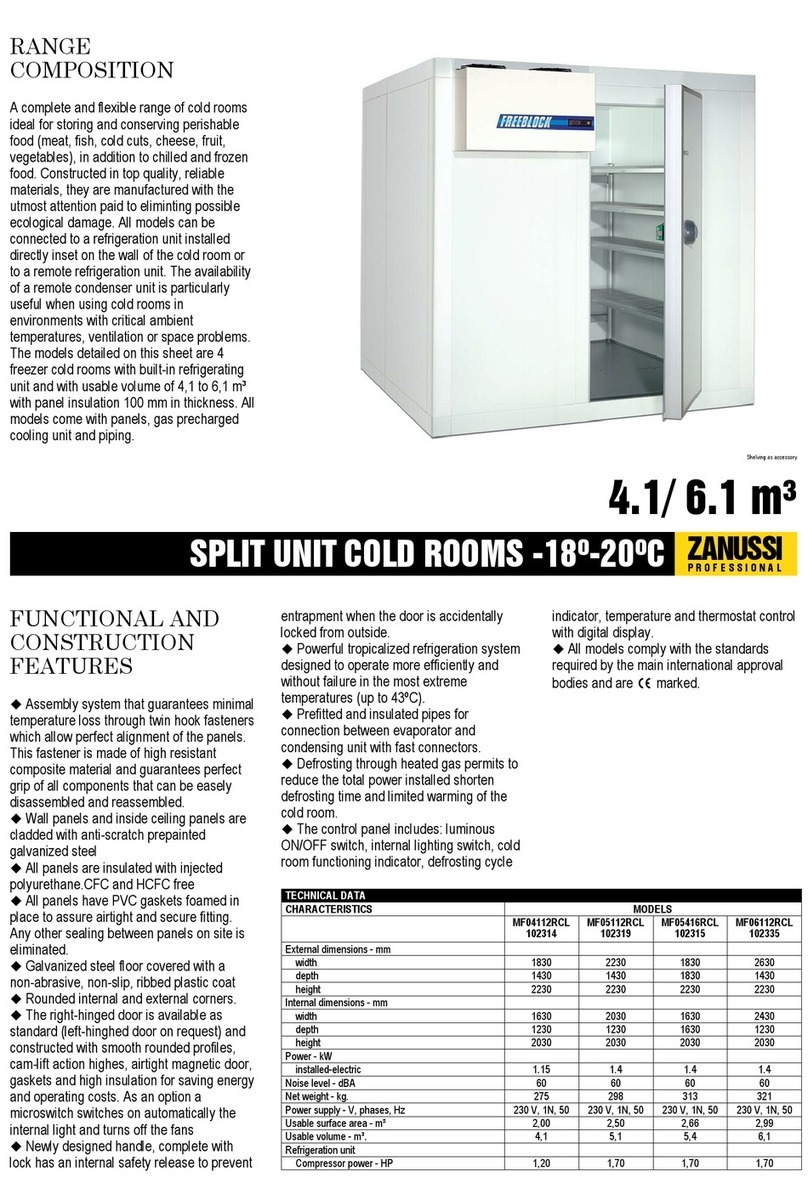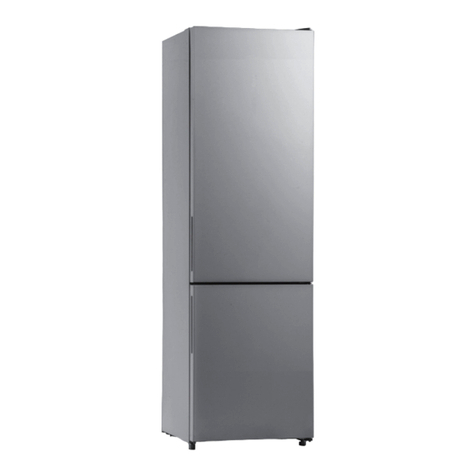Forte F9BFRESIC450PR User manual

Refrigerator
Instruction Manual
Model: F9BFRESIC450PR

1
SUMMARY
SAFETY INFORMATION ............................................... 2
SCRAPPING OLD APPLIANCES......................................6
Energy Saving...........................................................7
Before first use ......................................................... 7
Fridge use................................................................ 8
Freezer use ..............................................................9
Chiller Zone drawer ................................................... 9
Storage .................................................................. 10
Control panel .......................................................... 11
Instructions for Ice Maker ..................................... 13
LED light replacement instructions.......................... 14
Care and Cleaning; Defrosting................................ 15
Troubleshooting ........................................................ 16
Installation preparation ........................................... 17
Ventilation........................................................... 18
Installation Instruction .......................................... 21
Reversing the appliance doors..................................... 25

2
Thank you for purchasing this product.
Before using your refrigerator, please carefully read this instruction manual
in order to maximize its performance. Store all documentation for
subsequent use or for other owners. This product is intended solely for
household use or similar applications such as:
The kitchen area for personnel in shops, offices and other
working environments On farms, by clients of hotels, motels
and other environments of a residential type At bed and
breakfasts(B&B)
For catering services and similar applications not for retail sale.
This appliance must be used only for purposes of storage of food, any other
use is considered dangerous and the manufacturer will not be responsible
for any omissions. Also, it is recommended that you take note of the
warranty conditions.
SAFETY INFORMATION
This is the Safety Alert Symbol. This symbol alerts you to potential
hazards that can kill or injure you and others. All safety messages will follow the
Safety Alert Symbol and either the words” DANGER”, “WARNING” or “CAUTION”.
Danger means that failure to heed this safety statement may result in severe
personal injury or death.
Warning means that failure to heed this safety statement may result in extensive
product damage, serious personal injury, or death.
Caution means that failure to heed this safety statement may result in minor or
moderate personal injury, or property or equipment damage.
All safety messages will alert you to what the potential hazard is, tell you how to
reduce the chance of injury, and let you know what can happen if the instructions
are not followed.

3
If the supply cord is damaged, it must be replaced by the manufacturer, its service
agent or similarly qualified persons in order to avoid a hazard.
This appliance is not intended for use by persons (including children) with reduced
physical, sensory or mental capabilities, or lack of experience and knowledge, unless
they have been given supervision or instruction concerning use of the appliance by a
person responsible for their safety.
Children should be supervised to ensure that they do not play with the appliance.
This appliance can be used by children aged from 8 years and above and persons
with reduced physical sensory or mental capabilities or lack of experience and
knowledge if they have been given supervision or instruction concerning use of the
appliance in a safe way and understand the hazards involved. Children shall not play
with the appliance. Cleaning and user maintenance shall not be made by children
without supervision.(EU)
Keep the appliance and its cord out of reach of children less than 8 years.(EU).
Do not store explosive substances such as aerosol cans with a flammable propellant
in this appliance.
The max. loading of shelve is 22 lbs(10kg).
The appliance shall be used at an ambient temperature listed according to it’s
climate class:
89 °F(32℃)± 35 °F(2℃)on appliances of climatic class 0,1,2,3,4,6 or 8;
109 °F (43°C)± 35 °F(2℃)Con appliances of climatic class 5 or 7.
The appliance use flammable insulation blowing gas C5H10, disposal of the
appliance shall in accordance with the regulations of local authorities.
The appliance provided with double-capped fluorescent lamps, the lamp has to be
replaced by identical lamps only.
The key for appliance electric box should be safe kept by qualified persons in order
to avoid a hazard
Based on business order(s) to EU market, give true EU authorized representative
information on the label with full business name and full EU address in the marking
plate.
If the appliance use flammable refrigerant, such as R600a, R290:

4
Warning; Risk of fire / flammable materials
WARNING: Keep ventilation openings, in the appliance enclosure or in the built-in
structure, clear of obstruction.
WARNING: Do not use mechanical devices or other means to accelerate the
defrosting process, other than those recommended by the manufacturer.
WARNING: Do not damage the refrigerant circuit.
WARNING: Do not use electrical appliances inside the food storage compartments
of the appliance, unless they are of the type recommended by the
manufacturer.
WARNING:When positioning the appliance, ensure the supply cord is not trapped or
damaged.
WARNING: Do not locate multiple portable socket-outlets or portable power supplies
at the rear of the appliance.
WARNING:Do not store explosive substances such as aerosol cans with a
flammable propellant in this appliance.
WARNING:To avoid a hazard due to instability of the appliance, it must be fixed in
accordance with the instructions
Handling, moving, and use of the refrigerator or freezer to avoid either damaging the
refrigerant tubing, or increasing the risk of a leak
L’opération, le mouvement et l’utilisation du réfrigérant ou le congélateur doivent
éviter les dommages du tuyau réfrigérant ou le rique de la fuite.
Caution – Risk of Fire or Explosion due to Flammable Refrigerant Used. Follow
Handling Instructions Carefully in Compliance with U.S. Government Regulations
Component parts shall be replaced with like components and that servicing shall be
done by factory authorized service personnel, so as to minimize the risk of possible
ignition due to incorrect parts or improper service.
Les pièces de rechange doivent être remplacées par les components relatifs et les
opérations doivent être faites par les professionnels afin de minimaliser le risque
d’allumage à cause des parts incorrects ou des opérations impropres.
CAUTION – Risk Of Fire Or Explosion Due To Puncture Of Refrigerant Tubing;
Follow Handling Instructions Carefully. Flammable Refrigerant Used

5
DANGER: Risk of child entrapment. Before you throw away your old refrigerator or
freezer:Take off the doors Leave the shelves in place so that children may not easily
climb inside.
DANGER:If the LED lamp is damaged, it must be replaced by the manufacturer, its service
agent or similarly qualified persons in order to avoid a hazard
DANGER-Risk Of Fire or Explosion.Flammable Refrigerant Used. Do Not Use
Mechanical Devices To Defrost Refrigerator.Do Not Puncture Refrigerant Tubing.
Danger-rique de feu ou explosion. Les articles inflammbles réfrigérants utilisés. Ne
pas utiliser les appareils mécaniques pour décongeler le réfrigérant.
DANGER-Risk Of Fire Or Explosion.Flammable Refrigerant Used. To Be Repaired
Only By Trained Service Personnel.Do Not Puncture Refrigerant Tubing.
Danger-rique de feu ou explosion. Les articles inflammbles réfrigérants utilisés.Il faut
être réparé par les professionnels seuls. Ne pas crever le tuyau réfrigérant.
CAUTION-Risk Of Fire Or Explosion.Flammable Refrigerant Used. Consult Repair
Manual/Owner's Guide Before Attempting To Service This Product. All Safety
Precautions Must be Followed.
Attention-rique de feu ou explosion. Les articles inflammbles réfrigérants
utilisés.Consultez la specification de réparation/le guideavant d'essayer de utiliser ce
produit.Toutes les précautions en sécurité doivent être respectées.
CAUTION-Risk Of Fire Or Explosion.Dispose Of Property In Accordance With
Federal Or Local Regulations. Flammable Refrigerant Used
Attention-rique de feu ou explosion. Détnlire la propriété selon les regulations
fédérales ou locales. Les articles inflammbles réfrigérants utilisés.
CAUTION-Risk Of Fire Or Explosion DueTo Puncture Of Refrigerant Tubing;Follow
Handling Instructions Carefully.Flammable Refrigerant Used
Attention-rique de feu ou explosion. Il faut crever le tuyau réfrigérant selon
I'instruction d'opérations. Les articles inflammbles réfrigérants utilisés.

6
This appliance is intended to be used in household and similar applications such as
–staff kitchen areas in shops, offices and other working environments;
–farm houses and by clients in hotels, motels and other residential type
environments;
–bed and breakfast type environments;
–catering and similar non-retail applications.
Disposal of Old Appliance
Dispose of your appliance packaging properly. Refrigeration equipment must be
properlydisposed of in a way which protects the environment. This applies to your old
appliance and to your newunit once it has reached the end of its service life.
Please according to local regulations regarding disposal of the appliance for its
flammable refrigerant and blowing gas.
WARNING: Please ensure that old, worn appliances are rendered unusable before
disposal by removing the plug, cutting the power cable, and removing or destroying
any snap fastenings or bolts. You will thus prevent children from locking themselves
in the appliance during play (risk of suffocation) or endangering their lives in any other
way.
The appliance must not be disposed with normal household waste collection.
The coolant circuit, particularly the heat exchange at the back/bottom of the unit,
must not be damaged.
The symbol on the product or its packaging indicates that this product is not to be
handled as normal household waste but is to be taken to a recycling collection point
for electrical and electronic goods. By correctly disposing of this product you are
contributing to the protection of the environment. Improper disposal endangers health
and the environment. Further information about the recycling of the product may be
obtained from your town hall or local waste collection department.

7
Energy Saving
For better energy saving we suggest :
•Installing the appliance away from heat sources and not exposed to direct sunlight and in a
well ventilated room.
•Avoid putting hot food into the refrigerator to avoid increasing the internal temperature
and therefore causing continuous functionalizing of the compressor.
•Do not excessively stuff foods so as to ensure proper air circulation.
•Defrost the appliance in case there is ice to facilitate the transfer of cold.
•In case of absence of electrical energy, it is advisable to keep the refrigerator door closed.
•Open or keep the doors of the appliance open as little as possible
•Avoid adjusting the setting to temperatures too cold.
•Remove dust present on the rear of the appliance
Before first use
You must allow the fridge to settle for at least four hours prior to switching the
power on.
It is recommended that you clean the interior of the appliance prior to first use, using a
solution of bicarbonate of soda and warm water and then thoroughly drying the interior.
The fridge may have an odor to it at first use. This will disappear as the appliance cools.
Please note:
The appliance will start 41 °F (5°C) for fridge and -0.5 °F(-18℃) for freezer and work
continuously until it comes down to the correct temperature. If the appliance is switched
off, you should allow five minutes before switching it on again to prevent unnecessary
damage to the compressor. Never store inflammable or explosive items and strong
corrosive acids or alkalis in the appliance. This fridge cools your food by making the inside
back of the cavity cold. It is normal for frost to build up on this surface; it then dissipates
and drains through a small drain at the bottom, where it evaporates harmlessly. The
presence of frosting at the back is not a malfunction of the fridge.

8
Fridge use
Never put liquids in the refrigerator uncovered.
Never put hot foods in the refrigerator. Warm food should be allowed to cool
to room temperature before being put into the refrigerator.
Nothing should rest against the rear wall of the refrigerator, as this will
cause frost and possible condensation problems which will be difficult to
remove.
Make sure food is clean and any extra water is wiped away before putting
into the fridge.
Wrap or cover food before putting into the fridge. This will help prevent the loss of
moisture, keep food fresh and avoid unpleasant odors.
Sort foods prior to storing. Any foods to be used soon should be stored at the
front of the shelf to prevent deterioration caused by the door being open for
prolonged periods.
Do not overfill the fridge. There should be sufficient space between the
foods to allow the cool air to circulate.
Thawing frozen foods in the fridge compartment will help to keep the
temperature low and save energy.
Never store raw meats on shelves above cooked meats or other produce. This
will help to prevent juices from raw meat contaminating other foodstuffs.

9
Freezer use
The freezer compartments are designed to store only frozen food.
Never put hot or warm foods in the freezer, allow them to cool fully before
putting them into the freezer.
Follow the instructions on the food packaging for storage of frozen food. If
no information is provided, foods should not be stored for more than
three months after the purchase date.
Store food in small packages (ideally less than 2.2 lbs (1kg) ).This reduces
the freezing time and improves the quality of the food after thawing.
Wrap food before putting into the freezer. To stop the wrapping
sticking together, ensure it is dry.
Label the food before freezing with information including type of food and
dates of storage and expiry.
Once food is thawed, it must not be refrozen. Only defrost as much food as
is required to prevent wastage.
Bottled or canned drinks should not be stored in the freezer
compartments as they could explode.
The maximum amount of fresh food that can be frozen within a 24 hour
period is 5.8 lbs ( 2.6kg).
Do not attempt to freeze more than the maximum amount.
Chiller Zone drawer
The temperature inside the My Zone drawer can be regulated from
37°F(3°C) to 26°F (-3°C). This is the ideal drawer to store meat and fish.
.

10
Storage
The fridge section is for short term food storage. Although low temperatures can be
maintained, extended periods of food storage is not recommended.
As the cold air circulates within the fridge, the temperature can vary between
the different sections. As such, foods should be stored in different sections
according to type.
1. Butter, cheeses etc.
2. Food in jars and bottles
3. Drinks, e.g. milk
4. Cooked food
5. Yogurts, preserves etc.
6. 75cl bottles or ready meals etc.
7. Fruit and vegetables
8. Fresh meat and fish/fruit and vegetables
9. Storage of ice cubes
The fridge shelves can be moved according to the
storage requirements within the fridge section. To
move the shelf, lift up the rear section and then
pull it outwards.
To replace, slide the shelf back into the slot, and
then lower the rear section.
The most energy-saving configuration requires
drawers, food box and shelves to be positioned
in the product, please refer to the above
pictures.

11
Control panel
1. First time switching on the appliance, this appliance always works at settings:
41 °F (5°C) for
fridge, 32°F (0°C) for My Zone 0.5 °F(-18℃). If you want to adjust the temperature or functions
manually, press the button to conduct the operations. Temperature of the zone ranges from
37°F(3°C) to 26°F (-3°C).
2. Fridge temperature adjustment –press button on left part of control panel to achieve
different temperatures from 35°F (2℃) to 46°F ( 8℃).
3. Freezer temperature adjustment –press button on right part of control panel to
achieve different temperatures from
5°F(-15)℃to-15°F(-25℃).
4. Chiller Zone drawer adjustment function: this button controls temperature. By
pressing on this button, the digit will go from
37°F(3°C) to 26°F (-3°C). This function can be
on/off by continuously pressing for three seconds (shows OFF).
5. Fast cooling function –Press button , light of button illumines and fast cooling function is
turned on, fridge starts to work automatically at temperature setting 35°F(2℃) and quits after 24
hours, light of symbol eliminates.
6. Holiday function–Press button , light of button illumines, holiday function is turned on and
whole appliance starts to work automatically at settings: fridge at 62°F(17℃) and freezer at -
0.5°F(-18℃).
7. Eco function – Press button on control panel, eco function is turned on and button
illuminates, fridge compartment works at setting 41°F (5°C) and freezer compartment works at
setting of-0.5°F(-18℃).The adapt zone works at setting of
37°F(3°C).
8. Fast freezing function –Press button , light of button illumines and freezer start to
work at fast freezing function, temperature setting -15°F(-25℃). After 24 hours, fast freezing
function quits automatically.
9. Press button for 3 seconds to switch off your appliance and the button illumines, power is cut
off. Internal lamps illuminate, compressor stops. Pressthe button for 3 seconds to

12
switch on your appliance, the symbol illuminates and power is connected again.
10. On the no frost models, there is a function: compulsive defrosting. Press the buttons
+ for 5 seconds to switch on the compulsive defrosting function to clean the freezer
evaporator and digitals of freezer temperature shine. Press the button +3 seconds
to switch off the compulsive defrosting function , and the digitals of freezer temperature
eliminate.
10 Fault display
This appliance has ‘fault display & alarm’ function. Once the sensors got fault, there are alarms
displayed on the temperature displaying, the appliance still cools but professional service engineer
should be called and check the appliance.
F2 – Sensor of adapt zone
F3 – Sensor of fridge apartment
F4 – Sensor of freezer
compartment
F5 – Sensor of defrosting
2E – Fault of fan/motor in freezer
CE– Communication fault between main panel and display panel.
The above Errors only show on display, no voice
Over temperature alarm in freezer: after freezer temperature arrives at the set
temperature, after that, if the temperature rises to >77°F (-1 °C), the alarm
will start, accompany with flash of freezer temperature digit. Press any button to
cancel the voice alarm. The flash will remain until the temperature is <77°F (-1
°C).
PS: Main board locates in compressor compartment
POSITION
CONDITIONS
41 °F (5°C) - -0.5 °F(-18℃)
Summer or ambient temperature between
77°F(25°C) - 95°F ( 35 °C)
41 °F (5°C) - -0.5 °F(-18℃)
Spring or ambient temperature between
59°F(15°C) - 77°F ( 25 °C)
41 °F (5°C) - -0.5 °F(-18℃)
Winter or ambient temperature between
41°F(5°C) - 59°F ( 15 °C)
Super freezing function
Quick freeze
Super cooling function
Super cooling

13
Instructions for Ice Maker(if applicable)
1. Connect the waterpipe connector to water source, and check for any connector leakages
after water is supplied.
2.Open the freezer door, pull out the ice box, and turn on the ice maker for ice making; Then,
install back the ice box.
3.The ice maker indicator shows yellow and is flashing, indicating that ice-making is in process.
4.The ice maker indicator shows yellow and is not flashing, indicating that the ice box is full and
ice making is paused.
5.The ice maker indicator shows red and is flashing, indicating that the ice box is not in position
or has been pulled out.
6. The ice maker indicator shows red and is not flashing, indicating that the ice maker is malfunctioning

14
LED light replacement instructions
Note: the LED light is set to be non-replaceable by the user and needs to be replaced
by professionals.
Lighting parameters: 12V / 10W
1. Unplug the power plug.
2. Remove the aluminum alloy trim strip on the top of the LED surface light source,
and then remove the left and right fixing screws.
Steps ①and ②are shown below.
3. Replace the spare LED light board.
4. Replace the aluminum alloy trim strip in turn.

15
Care and Cleaning
Always disconnect the appliance from the power supply before any cleaning or
maintenance.
The fridge and freezer sections should be cleaned using a solution of bicarbonate of
soda and lukewarm water. Do not use abrasive products or detergents. After washing,
rinse and dry thoroughly.
Clean the shelves and balconies separately by hand with a mild solution of washing up
liquid and water. Do not put them in the dishwasher.
If the appliance is not to be used for prolonged periods of time, unplug and clean the
appliance. The doors should be left slightly ajar to prevent the formation of mildew and
unpleasant odors.
Defrosting
The product has a no frost system which is designed to prevent the heavy build up of ice.
Under normal use, there should be no need to regularly defrost the freezer system.
Please note: If you are regularly finding a heavy build up of ice, or pools of water, in the
freezer section then it is likely that the door is not sealing properly. This could be due to a
defective door seal or an incorrectly fitted, or overly heavy, decor door. For more
information see the troubleshooting section about ice.

16
Troubleshooting
If you have any problems with your appliance, you should check the troubleshooting prior to calling
Customer Care.
If the appliance is not working, check:
That there is power to the appliance.
The house fuses are intact and the fuse in the plug has not blown.
The fridge has not been turned off.
The plug socket is functioning fine. To check this, plug another
electrical appliance in to see if the socket is faulty.
If the appliance is working, but not very well, check:
The appliance is not overloaded.
The thermostat is set to an appropriate temperature.
The doors are closing properly.
The cooling system at the rear of the appliance is clean and free of
dust, and not touching the rear wall.
There is enough ventilation at the side and rear walls.
If the appliance is noisy, check:
The appliance is level and stable.
The side and rear walls are clear, and there is nothing resting on the
appliance.
Note: The cooling gas in the refrigerator may make a slight bubbling or
gurgling noise, even when the compressor is not running.
If the appliance is beeping, check:
That the doors are closed. An alarm will sound after 60 seconds of a
door being open.
If ice has formed on the back wall of the fridge:
It is normal for some ice droplets to form on the back wall of the fridge.
This does not constitute a fault with the appliance.
Ensure that no items inside the fridge are in contact with the back
wall.

17
Check that there is some resistance when opening the door of the
appliance. If it opens at the slightest touch it may mean that the door
seal needs to be replaced.
Check the door seal for any kinks, debris or damage. If you notice any,
and are unable to resolve the issue yourself, contact Customer Care so
that the seal can be replaced.
This can be due to the decor door(s) not being properly fitted. If you
are at all unsure, ask your fitter to check the décor doors.
If excessive ice has formed in the freezer:
Check that there is some resistance when opening the door of the
appliance. If it opens at the slightest touch it may mean that the door
seal needs to be replaced.
Check the door seal for any kinks, debris or damage. If you notice any,
and are unable to resolve the issue yourself, contact Customer Care so
that the seal can be replaced.
This can be due to the decor door(s) not being properly fitted. If you are at all unsure,
ask your fitter to check the decor doors.
If one or more of the LED units within the appliance is not working:
Contact Customer Care to arrange a service visit.
Installation preparation
This appliance must never be installed close to heat sources, e.g. heating elements
or cookers, nor in damp places.
Seek the help of another individual, or two, when installing this appliance. This
appliance may have sharp edges. Wear adequate PPE for the task and
environment.
To ensure the appliance is level, you should use the height
adjustable feet at the front of the appliance.
The cooling system at the rear of the appliance must not
touch the rear wall. The greater the gap, the better.
The appliance must be installed with adequate ventilation.
Ensure that there is clearance above the appliance to allow
air to escape and that there is space between the rear of the
appliance and the wall.

18
Ventilation
The main consideration when installing
any refrigeration unit into a fitted kitchen
is ventilation. The heat removed from the
cooling compartment needs to be
dissipated into the atmosphere. Incorrect
ventilation can lead to premature
compressor failure, excessive power
consumption, total system failure and
may invalidate the warranty provided
with the appliance. For products intended
to be installed into a tall housing unit, the
following requirements need to be met:

19
F9BFRESIC450PR
Suggested Panel Height for Fridge Door: 42 7/8 inches – 43 inches
Suggested Panel Height for Freezer Door: 28 inches
Suggested Width for Both Doors: 22 13/16 inches
**These are only suggestions and may be adjusted depending on your specific cabinet
dimensions.**
Table of contents
Other Forte Refrigerator manuals

Forte
Forte F12BFRES450RWW User manual
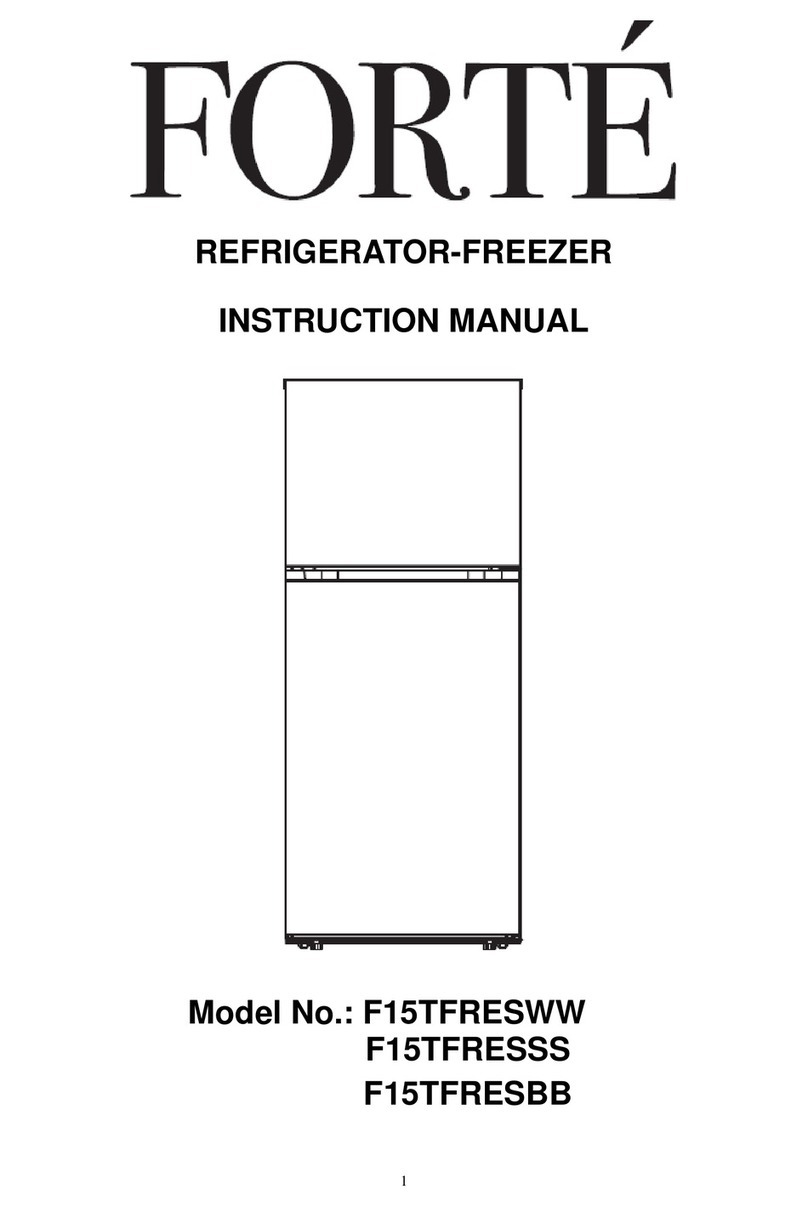
Forte
Forte F15TFRESWW User manual
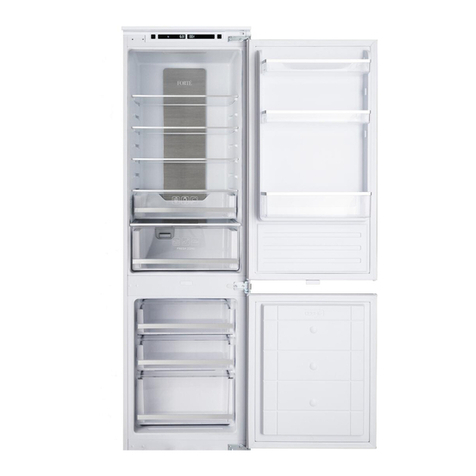
Forte
Forte 450 Series User manual
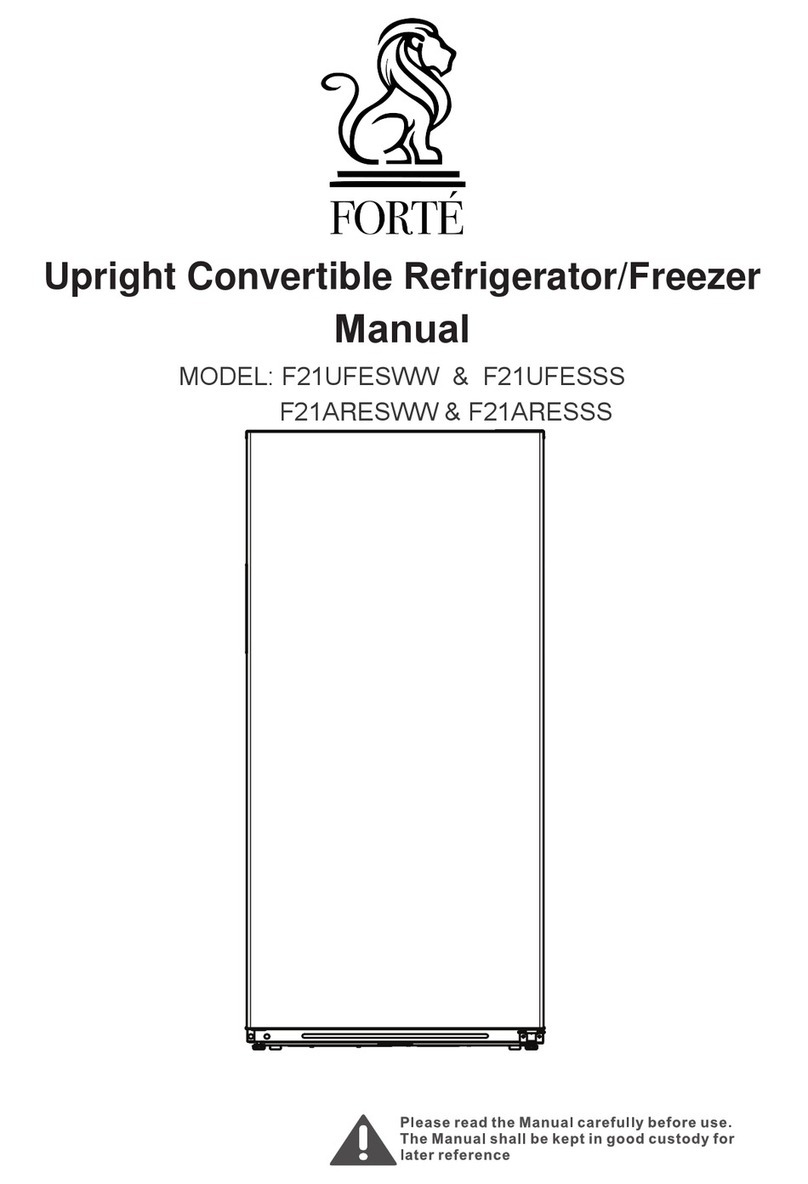
Forte
Forte F21UFESWW User manual
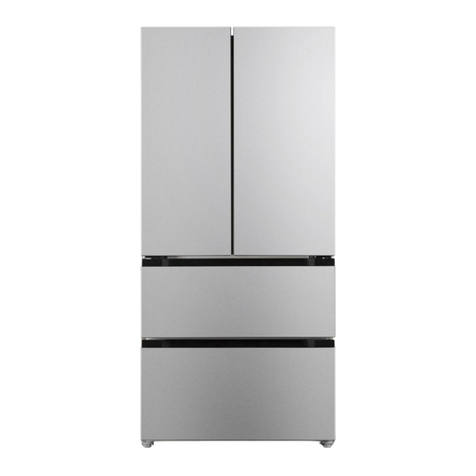
Forte
Forte FFD18ESC250SS User manual
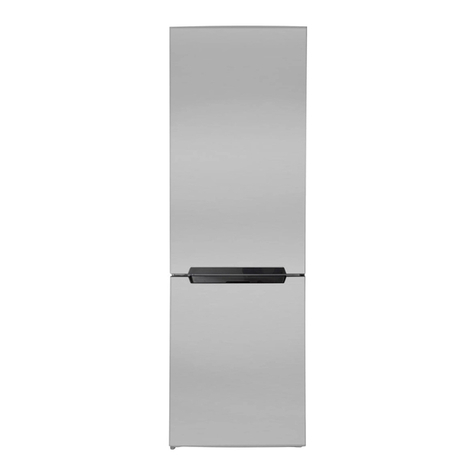
Forte
Forte F12BFRES450SS User manual

Forte
Forte 450 Series User manual
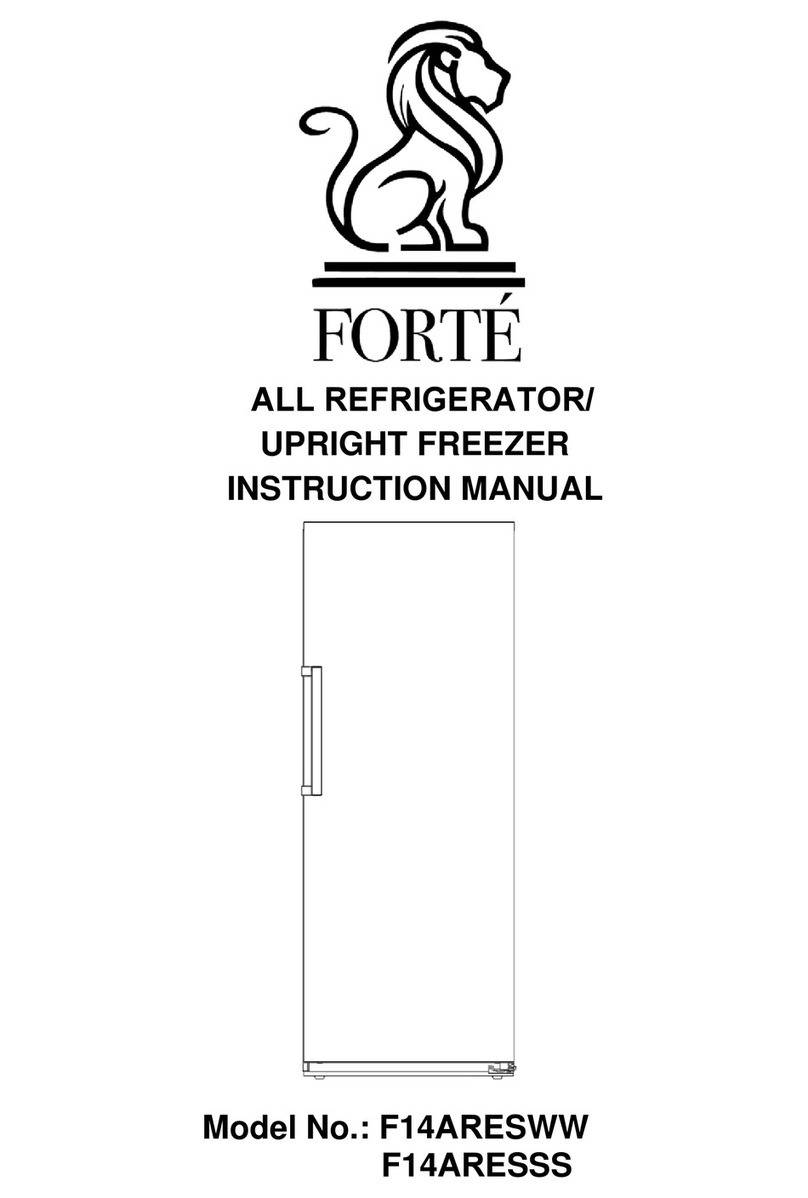
Forte
Forte F14ARESWW User manual

Forte
Forte F21UFLESSS User manual
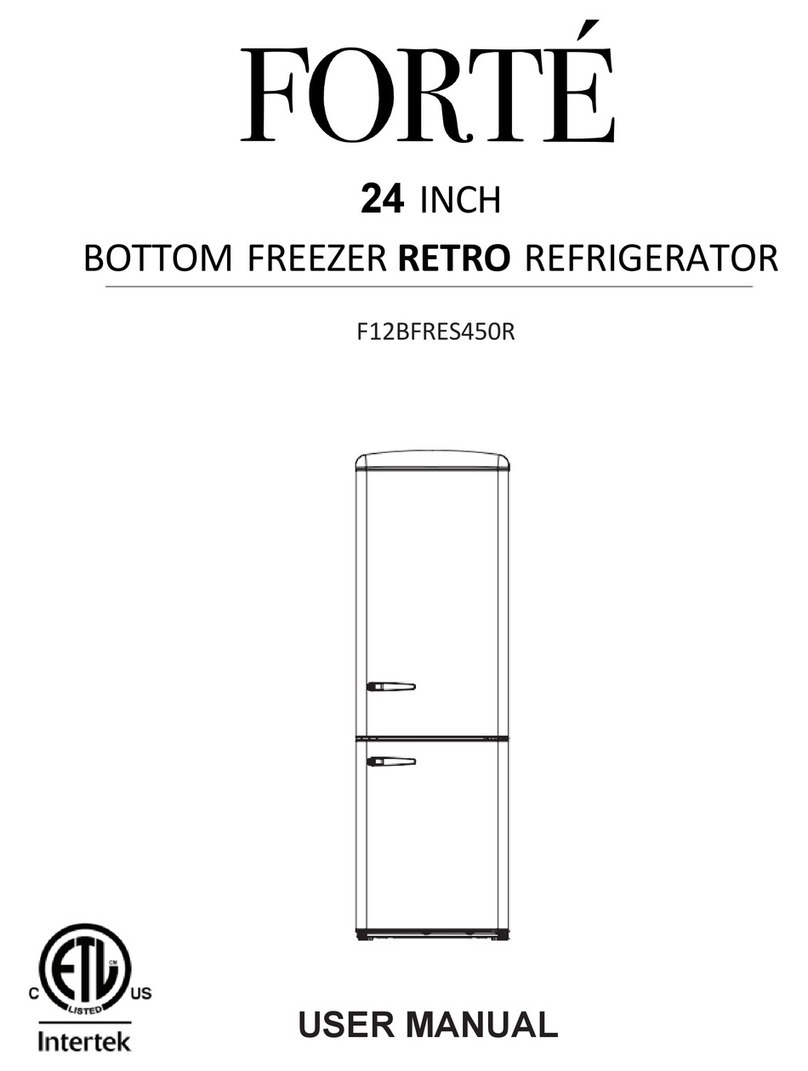
Forte
Forte F12BFRES450R User manual
Popular Refrigerator manuals by other brands
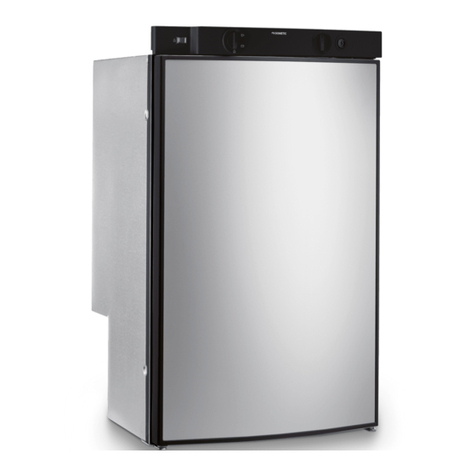
Dometic
Dometic 8 Series installation manual
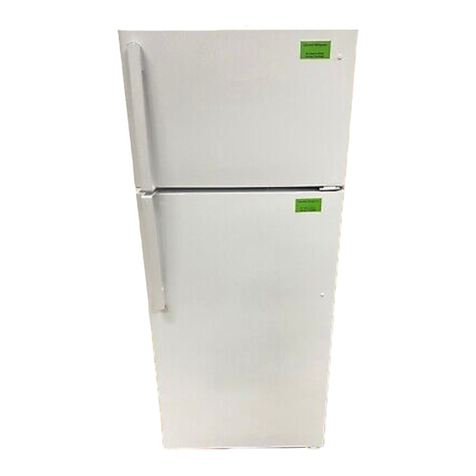
GE
GE GTS18 Owner's Manual & Installation Instructions
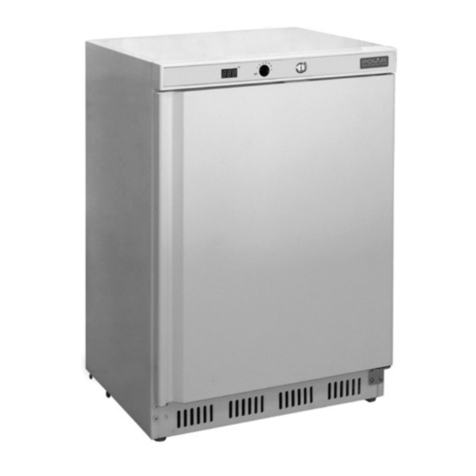
Polar Electro
Polar Electro CD610 instruction manual
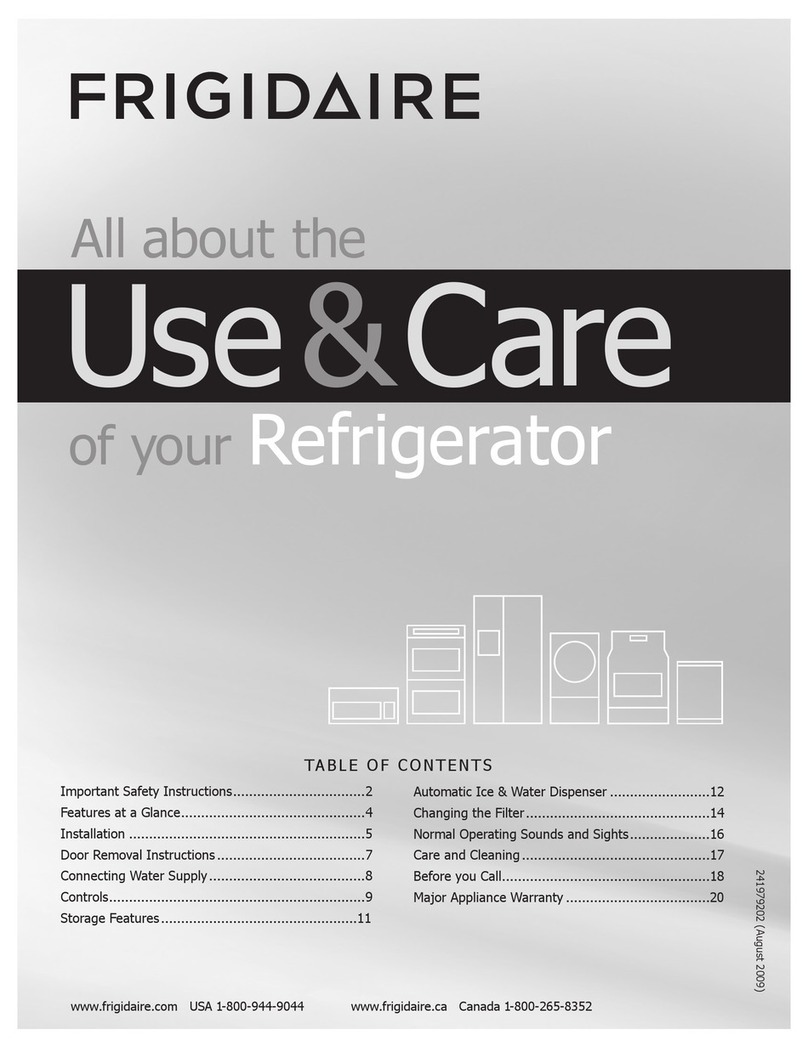
Frigidaire
Frigidaire FGHC2334KP - Gallery 22.6 Cu. Ft. Side use and care manual

Sub-Zero
Sub-Zero 700BC install guide
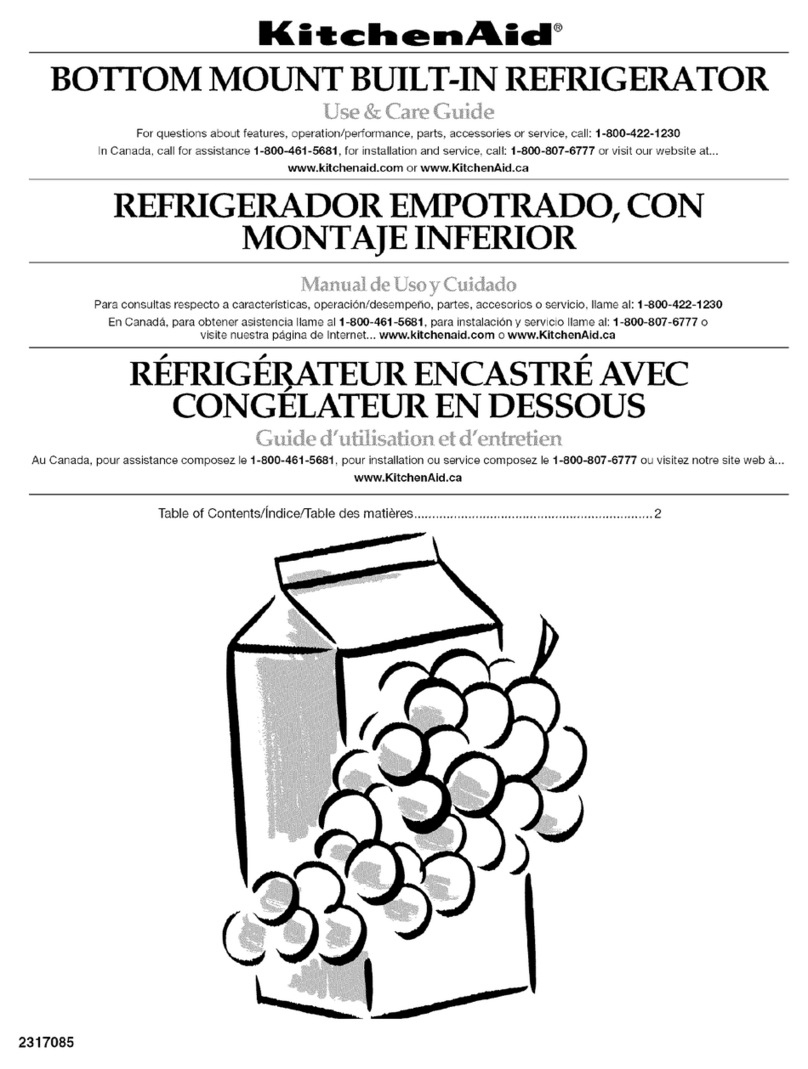
KitchenAid
KitchenAid KBRC36FMS02 Use & care guide
